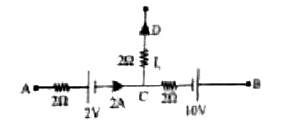1 V equals
1J
1JC−1
1CJ−1
1JC
The correct Answer is:B
To solve the question "1 V equals", we need to understand the relationship between volts, joules, and coulombs. Here’s a step-by-step breakdown:
Step 1: Understand the Definition of Volt
1. Definition: A volt (V) is defined as the potential difference that will move one coulomb of charge with one joule of energy.
2. Formula: This can be expressed with the formula:
V=WQ
where V is the potential difference in volts, W is the work done in joules, and Q is the charge in coulombs.
Step 2: Rearranging the Formula
1. Rearranging: From the formula, we can rearrange it to find the relationship between volts, joules, and coulombs:
V=WQ⟹1 V=1 J1 C
This means that 1 volt is equal to 1 joule per coulomb.
Step 3: Conclusion
1. Final Answer: Therefore, we conclude that:
1 V=1 joule per coulomb
Step 4: Check the Options
1. Options: The options given were:
- 1 joule
- 1 joule per coulomb
- 1 coulomb per joule
- 1 joule per coulomb (repeated)
2. Correct Option: The correct answer is "1 joule per coulomb".
Final Answer
Thus, we conclude that:
1 V equals 1 joule per coulomb.
---
1. Definition: A volt (V) is defined as the potential difference that will move one coulomb of charge with one joule of energy.
2. Formula: This can be expressed with the formula:
V=WQ
where V is the potential difference in volts, W is the work done in joules, and Q is the charge in coulombs.
1. Rearranging: From the formula, we can rearrange it to find the relationship between volts, joules, and coulombs:
V=WQ⟹1 V=1 J1 C
This means that 1 volt is equal to 1 joule per coulomb.
1. Final Answer: Therefore, we conclude that:
1 V=1 joule per coulomb
1. Options: The options given were:
- 1 joule
- 1 joule per coulomb
- 1 coulomb per joule
- 1 joule per coulomb (repeated)
2. Correct Option: The correct answer is "1 joule per coulomb".
Thus, we conclude that:
1 V equals 1 joule per coulomb.
Topper's Solved these Questions
- MISCELLANEOUS QUESTIONSBOOK - MCGROW HILL PUBLICATIONCHAPTER - MISCELLANEOUS QUESTIONSEXERCISE - PART-B
99 Videos
- MEASUREMENTBOOK - MCGROW HILL PUBLICATIONCHAPTER - MEASUREMENTEXERCISE - ELEMENTARY QUESTIONS (HIGHER ORDER THINKING QUESTIONS)
13 Videos
- MOTIONBOOK - MCGROW HILL PUBLICATIONCHAPTER - MOTIONEXERCISE - HIGHER ORDER THINKING QUESTIONS
48 Videos
Similar Questions
Knowledge Check
For the circuit shown in figure when R=2Ω,V=0.75vo<s, when R=3Ω, V = 0.9 VoltswhenR = 4Omega, V = V_(1),whereV_(1)equals(∈vo<s)andI_(1)(in amp)
 A11=1.2ABV1=1.5VCI1=1.0ADV1,=1.0V
A11=1.2ABV1=1.5VCI1=1.0ADV1,=1.0VA solid sphere, of radius R acquires a terminal velocity v1 when falling (due to gravity) through a viscous fluid having a coefficient of viscosity η he sphere is broken into 27 identical solid spheres. If each of these spheres acquires a terminal velocity v2 when falling through the same fluid, the ratio (v1/v2) equals:
A1/27B27C9D1/9A part of a circuit is shown in figure VR−VC is equal to 12 V. I1 is equal to
 A1AB2AC3AD4A
A1AB2AC3AD4A
If the variance of the first 50 odd natural numbers is V1 and the variance of next 50 odd natural numbers is V2, then V1+V2 is equal to
View SolutionStandard deviation of two distributions are same and their arithmetic means are 30and 25 respectively. If their coefficient of variations are (v1) and (v2), then (6v1)−(5v2) is equal to
View SolutionIf a2+1a2=7andV1andV2 are the minimum and the maximum values of a3+1a3,then V2−V1 is equal to ?
View SolutionIn Region of Electric field Given by →E=(Ax−B)ˆI. Where A=20 unit and B=10 unit. If Electric potential at x=1m is v2. Then v1−v2 is equal to
View SolutionConsider the following statements.
p : if 7 is an odd number , then 7 is divisible by 2.
Q : If 87 is a prime number , then 7 is an odd number .
if V1 is the truth value of contrapositive of p and V2 is the truth value of conirapositive of Q, then the ordered pair (V1,V2) equals.
View Solution
